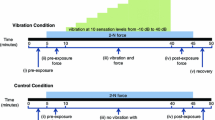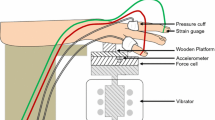Summary
Circulatory disturbances of the foot in patients with vibration syndrome were studied by measuring the skin temperature of both index fingers and great toes through a 3-min immersion of the right foot in cold water at 10°C. Subjects included 11 patients with vibration-induced white finger (VWF) [VWF(+) group], 12 patients without VWF [VWF(−) group], and 20 healthy referents not exposed to vibration. Patients were all male chain saw operators who had scarcely been exposed to vibration of the foot. The prevalence of coldness felt in the upper and lower extremities was > 90% in the VWF(+) group, about 60% in the VWF(−) group, and < 10% in the referents. The extent of the coldness was greatest in the VWF (+) group. The skin temperature of both fingers and toes was lowest in the VWF(+) group, somewhat higher in the VWF(−) group, and highest in the referents both before and after immersion. These findings indicate that patients with vibration syndrome, especially those with VWF, have circulatory disturbances in the foot as well as in the hand. The disturbances in the foot may be related to long-term repeated vasoconstriction in the foot induced by hand-arm vibration through the sympathetic nervous system.
Similar content being viewed by others
References
Asaba G, Kimura A, Tsubahara A, Sakai H, Shinohara Y (1981) Effect of hot-spring baths on peripheral circulatory disorders in vibration disease (in Japanese). JJA Phys M Baln Clim 45:3–4
Bini G, Hagbarth K-E, Hynninen P, Wallin BG (1980) Regional similarities and differences in thermoregulatory vaso- and sudomotor tone. J Physiol 306:553–565
Burton AC (1939) The range and variability of the blood flow in the human fingers and the vasomotor regulation of body temperature. Am J Physiol 127:437–453
Ekenvall L, Lindblad LE, Bevegård S, Etzell B-M (1987) High vascular tone but no obliterative lesions in vibration white fingers. Am J Ind Med 12:47–54
Färkkilä M, Pyykkö I (1979) Blood flow in the contralateral hand during vibration and hand grip contraction of lumberjacks. Scand J Work Environ Health 5:368–374
Futatsuka M, Ueda T (1982) Quantitative observations on thermal and metabolic responses to cold of workers using vibrating tools. Int Arch Occup Environ Health 49:213–221
Futatsuka M, Pyykkö I, Färkkilä M, Korhonen O, Starck J (1983) Blood pressure, flow and peripheral resistance of digital arteries in vibration syndrome. Br J Ind Med 40:434–441
Gomibuchi R, Ohi T (1962) So-called “white waxy finger” (in Japanese). JJTOM 15:177–182
Hashiguchi T, Sakakibara H, Furuta M, Yamada S, Horio K, Toibana N (1988) Raynaud's phenomenon in the lower extremities induced by vibration exposure, report of three cases (in Japanese, with English abstract). JJTOM 36:651–657
Hashiguchi T, Sakakibara H, Yamada S (1990) Changes of skin blood flow in the finger and dorsum of the foot during chain saw operation. In: Okada A, Taylor W, Dupuis H (eds) Hand-arm vibration. Kyoei Press, Kanazawa, Japan, pp 133–135
Hedlund U (1989) Raynaud's phenomenon of fingers and toes of miners exposed to local and whole-body vibration and cold. Int Arch Occup Environ Health 61:457–461
Iki M, Kurumatani N, Hirata K, Moriyama T, Satoh M, Arai T (1986) Association between vibration-induced white finger and hearing loss in forestry workers. Scand J Work Environ Health 12:365–370
Kondo T, Sakakibara H, Miyao M, Akamatsu Y, Yamada S, Nakagawa T, Koike Y (1987) Effect of exposure to hand-transmitted vibration on digital skin temperature change. Ind Health 25:41–53
Nakamoto M (1990) Responses of sympathetic nerve system to cold exposure in vibration syndrome subjects and age-matched healthy controls. Int Arch Occup Environ Health 62:177–181
Nasu Y (1977) Changes of the skin temperature caused by local vibratory stimulation in normals and patients with vibration syndrome. Yonago Acta Med 21:83–99
Okada A (1990) Pathogenic mechanism of vibration-induced white finger (VWF) — recent findings and speculations. In: Okada A, Taylor W, Dupuis H (eds) Hand-arm vibration. Kyoei Press, Kanazawa, Japan, pp 1–8
Olsen N, Nielsen SL, Voss P (1982) Cold response of digital arteries in chain saw operators. Br J Ind Med 39:82–88
Olsen N, Fjeldborg P, Brøchner-Mortensen J (1985) Sympathetic and local vasoconstrictor response to cold in vibration induced white finger. Br J Ind Med 42:272–275
Pyykkö I, Hyvärinen J (1973) The physiological basis of the traumatic vasospastic disease: a sympathetic vasoconstrictor reflex triggered by high frequency vibration. Work Environ Health 10:36–47
Pyykkö I, Starck J, Färkkilä M, Hoikkala M, Korhonen O, Nurminen M (1981) Hand-arm vibration in the aetiology of hearing loss in lumberjacks. Br J Ind Med 38:281–289
Sakakibara H, Akamatsu Y, Miyao M, Kondo T, Furuta M, Yamada S, Harada N, Miyake S, Hosokawa M (1988) Correlation between vibration-induced white finger and symptoms of upper and lower extremities. Int Arch Occup Environ Health 60:285–289
Sakakibara H, Iwase S, Mano T, Watanabe T, Kobayashi F, Furuta M, Kondo T, Miyao M, Yamada S (1990) Skin sympathetic activity in the tibial nerve triggered by vibration applied to the hand. Int Arch Occup Environ Health 62:455–458
Suzuki Y, Nishiyama K, Nagayasu M, Nishihara S (1966) A case of the occupational Raynaud's phenomenon observed on the foot of a vibrating tool operator (in Japanese, with English abstract). Shikoku Acta Med 22:70–72
Toibana N, Ishikawa N (1990) The patients with Raynaud's phenomenon in fingers and toes caused by vibration. In: Okada A, Taylor W, Dupuis H (eds) Hand-arm vibration. Kyoei Press, Kanazawa, Japan, pp 245–248
Yamada S, Suzuki H, Maeda K, Takeuchi Y (1974) Skin temperature of the finger and value of nail press test under various environmental conditions in persons affected by vibration hazards (in Japanese, with English abstract). J Sci Labor 50:439–450
Author information
Authors and Affiliations
Rights and permissions
About this article
Cite this article
Sakakibara, H., Hashiguchi, T., Furuta, M. et al. Circulatory disturbances of the foot in vibration syndrome. Int. Arch Occup Environ Heath 63, 145–148 (1991). https://doi.org/10.1007/BF00379079
Received:
Accepted:
Issue Date:
DOI: https://doi.org/10.1007/BF00379079




